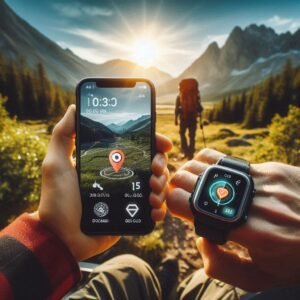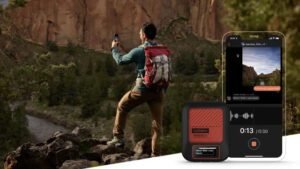Table of Contents
Staying Connected and Secure: Your Ultimate Guide to Cutting-Edge Wearables for Lone Explorers
Embarking on solo adventures can be an exhilarating experience, offering unparalleled freedom and self-discovery. However, it’s crucial to prioritize safety when venturing out alone.
Thanks to advancements in technology, wearable devices now offer a range of safety features and communication solutions that can provide peace of mind for solo adventurers.
This new and comprehensive OTL guide will explore the world of wearable tech designed specifically for safety during solo adventures.
We’ll look into key features, compare top devices, and provide recommendations to help you choose the best wearable tech for your needs.
Key Safety Features
When considering wearable tech for solo adventures, look for devices that offer the following key safety features:
1. Fall Detection: Automatically detects if you’ve fallen and can alert emergency services or contacts.
2. Emergency SOS: Allows you to quickly send an alert to emergency services or predetermined contacts with your location.
3. GPS Tracking: Enables real-time location tracking, which can be crucial in emergency situations.
4. Satellite Communication: Provides the ability to send messages or make calls in areas without cellular coverage.
5. Two-Way Communication: Allows you to communicate with emergency services or contacts directly through the device. We love ZOLEO and Garmin inReach devices!
6. Weather Alerts: Provides real-time weather updates and warnings for your location.
7. Offline Navigation: Offers GPS navigation capabilities without requiring an internet connection.
8. Long Battery Life: Ensures the device remains operational throughout your adventure.
9. Water Resistance: Protects the device from water damage during outdoor activities.
10. Durability: Withstands the rigors of outdoor adventures and extreme conditions.

Top Wearable Tech Devices for Solo Adventurers
1. Garmin inReach Mini 2
– Satellite communicator with two-way messaging and SOS capabilities
– GPS tracking and navigation
– Weather forecasts
– 14-day battery life in tracking mode
2. Apple Watch Ultra
– Fall detection and emergency SOS
– Built-in cellular capabilities
– GPS tracking and navigation
– Water resistance up to 100 meters
– Up to 60 hours of battery life in low power mode
3. Spot X Satellite Messenger
– Two-way satellite messaging
– GPS tracking and navigation
– SOS functionality
– 10-day battery life
4. Suunto 9 Peak Pro
– GPS tracking and navigation
– Weather alerts and storm warnings
– Water resistance up to 100 meters
– Up to 21 days of battery life in time mode
5. ACR ResQLink 400 – SOS Personal Locator Beacon with GPS
-406 MHz Emergency Distress Signal / Homing signal
-LED Strobe and Infrared Strobe
-Global Coverage / Cospas-Sarsat / MEOSAR
-GPS and Galileo GNSS
How to Choose the Right Device
When selecting a wearable tech device for your solo adventures, consider the following factors:
1. Type of Adventure: Different activities may require specific features. For example, a hiker might prioritize GPS navigation, while a scuba diver would need water resistance.
2. Duration of Trips: If you embark on extended adventures, prioritize devices with longer battery life.
3. Location: For remote areas without cellular coverage, satellite communication becomes essential.
4. Budget: Wearable tech can range from affordable to high-end luxury items. Determine your budget and find the best device within that range.
5. Comfort and Wearability: Choose a device that you’ll be comfortable wearing for extended periods.
6. Compatibility: Ensure the device is compatible with your smartphone and other gear you use.
7. Additional Features: Consider any extra features that might enhance your adventure experience, such as fitness tracking or altimeter functions.
Best Practices for Using Wearable Tech
1. Familiarize Yourself: Thoroughly read the user manual and practice using all features before your adventure.
2. Keep It Charged: Always start your adventure with a fully charged device and bring a portable charger if possible.
3. Update Emergency Contacts: Regularly update your emergency contact information on the device.
4. Test Regularly: Perform regular tests of the emergency features to ensure they’re working correctly.
5. Backup Plans: Don’t rely solely on technology. Always have backup plans and traditional navigation tools.
6. Weather Protection: Use protective cases or covers to shield your device from extreme weather conditions.
7. Software Updates: Keep your device’s software up to date to ensure you have the latest features and security patches.
8. Learn the Limitations: Understand what your device can and cannot do in various situations.

FAQs
Q: Are these devices waterproof?
A: While many devices offer water resistance, the level varies. Always check the specific water resistance rating for your device and understand its limitations.
Q: Do I need a subscription for satellite communication?
A: Yes, most satellite communicators require a subscription for their services. Check the provider’s plans and pricing before purchasing.
Q: Can these devices work without a smartphone?
A: It depends on the device. Some, like the Garmin inReach Mini 2 and Spot X, can function independently. Others, like many smartwatches, may require a smartphone connection for full functionality.
Q: How accurate is the GPS tracking on these devices?
A: GPS accuracy can vary depending on factors like satellite coverage and environmental conditions. However, most modern devices offer accuracy within 3-5 meters under good conditions.
Q: What happens if I accidentally trigger an SOS?
A: If you accidentally trigger an SOS, contact the emergency response center immediately to cancel the alert. Many devices have safeguards to prevent accidental activation.
Q: Can these devices be used internationally?
A: Most GPS and satellite communication devices work globally. However, check with the manufacturer for any country-specific restrictions or limitations.
Q: How often should I replace my wearable tech device?
A: This depends on usage and technological advancements. Generally, consider upgrading every 3-5 years to ensure you have access to the latest safety features.

Top Amazon Recommendations We Love & Use at Outdoor Tech Lab
1. [Garmin inReach Mini 2, Lightweight and Compact Handheld Satellite Communicator]
– Compact and lightweight design
– Two-way text messaging via Iridium satellite network
– Interactive SOS
– Battery life: up to 14 days at 10-minute tracking mode
2. [Apple Watch Ultra [GPS + Cellular 49mm] Smart Watch]
– Built-in cellular lets you call, text, and stream without your phone
– Advanced safety features including Fall Detection and Emergency SOS
– Customizable Action button for instant access to a variety of functions
– Up to 36 hours of battery life, up to 60 hours in Low Power Mode
3. [SPOT X 2-Way Satellite Messenger]
– 2-way satellite messaging
– GPS tracking and navigation
– S.O.S. to 24/7 Search & Rescue
– 240 hours (10 days) of battery life in 10-minute tracking mode
These recommendations provide a range of options to suit different needs and budgets, all while offering crucial safety features for solo adventurers.
Wearable tech has revolutionized safety and communication for solo adventurers, providing peace of mind and potentially life-saving features.
By understanding the key features, comparing top devices, and following best practices, you can choose the right wearable tech to enhance your solo adventures while prioritizing your safety.
Keep in mind, while these devices offer incredible capabilities, they should complement, not replace, proper planning, skill development, and common sense.
Always inform someone of your plans, carry traditional navigation tools, and trust your instincts.
With the right wearable tech by your side, you can embark on your solo adventures with confidence, knowing that help is just a button press away if you need it. Stay safe, stay connected, and enjoy the incredible experiences that solo adventures can offer!
Resources
Government Agencies:
- Federal Emergency Management Agency (FEMA): https://www.fema.gov/
- National Park Service: https://www.nps.gov/
- U.S. Forest Service: https://www.fs.usda.gov/

Introducing JC – The Outdoor Gear Enthusiast and Tester behind Outdoor Tech Lab:
Dive into the exciting world of outdoor gear technology with JC, the founder and driving force behind Outdoor Tech Lab.
With a passion for backpacking, nature and a knack for outdoors gadgets, JC has embarked on a mission to help others explore the outdoors in smarter, safer, and more enjoyable ways.
Join us on the adventure as we explore the ever-evolving landscape of outdoor gear & technology.
Through insightful reviews, practical tips, testing and engaging stories, Outdoor Tech Lab is your one-stop shop for navigating the wild world of outdoor gadgets and gear in 2024 and beyond.




Leave a Reply